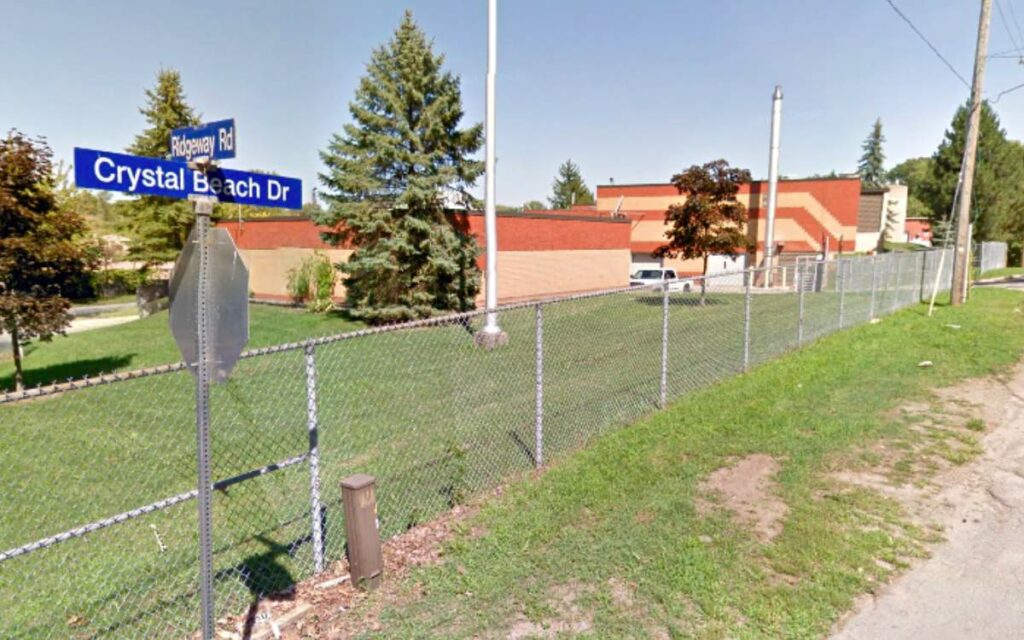
Last December, Niagara Region’s wastewater facility in Crystal Beach failed, resulting in 30 million litres of raw sewage dumping into Lake Erie. The public was not informed. Regional Council was not informed. Pictured is the Crystal Beach Wastewater Treatment Plant. Photo credit: Google Maps
The Region of Niagara is responsible for treating wastewater prior to discharging it into the environment. Overall, the cost of the service is taxed to residents and businesses by monthly water bills. Last year, Regional Council approved a 5.2 per cent increase to the water bill, with another 8.6 per cent increase this year.
With such a well-financed division, one would expect the Region’s wastewater department to be top-notch.
But it appears Niagara’s effluent operations aren’t performing as well as they should be – and the public is being kept in the dark about it.
Last December, regional staff received warnings of Winter Storm Elliot coming to the south shore of Niagara, most likely impacting the communities of Wainfleet, Port Colborne, Fort Erie, and Niagara Falls. The storm caused power failures across the region, resulting in loss of electricity to the Crystal Beach Wastewater Treatment Plant. After nine hours, the backup generators ran out of fuel, and up to 30 million litres of untreated raw sewage dumped into Lake Erie.
Niagara Regional Council is ultimately responsible for the water and wastewater system, per rules stemming from the Walkerton Inquiry, but Council members were not informed of the spill.
Upon learning of the spill from a constituent a few weeks ago, Regional Councillor for Niagara Falls Bob Gale promptly asked the next scheduled Audit Committee to review the system. In response, regional staff prepared a report stating, “action plans for remedying the spill were in place” and that “an extensive audit engagement would be a duplication of effort and should not be pursued”.
The staff report stated that management was aware of the incoming storm on December 22 and as a result, “increased staffing levels at key facilities”. However, when questioned by Councillor Gale what the increase in staffing levels was, and at what key facilities, a senior official in Wastewater Services responded, “we were facing a bit of a shortage because of the time of year, we had staffing level constraints around the Christmas time for obvious reasons, individuals are not compelled to take overtime shifts, it’s in the collective agreement that they can refuse that sort of thing so that definitely compounds the situation, and also at that time of year we are looking to use up a lot of vacation time, so it puts pressure on”.
In other words, although the staff report stated there was increased staffing, and upon questioning from Gale, staff disclosed no increased staffing actually occurred.
At the Crystal Beach wastewater treatment plant, the operator reportedly left the facility at 3:00pm on Friday afternoon, and the facility was then monitored remotely by a single staff member at the Seaway wastewater treatment plant in Port Colborne. The Seaway plant operator is responsible for monitoring the Crystal Beach facility Friday afternoon and throughout the weekend, in addition to the Port Colborne plant and 18 other stations.
According to the staff report, the storm hit the area on Friday, and power to the Crystal Beach plant was lost sometime after the operator left at 3:00pm. The backup generators can provide emergency power for only 12 to 24 hours, however, remote monitoring communication was lost nine hours after the operator left.
No one went to investigate the Crystal Beach plant until the following Sunday evening, when it was discovered that the generator was out of fuel, the louvres to keep the generator cool were stuck open, the water pipes burst, and the facility had completely failed.
At Audit Committee, a senior Wastewater Services official explained to Councillors that due to the road conditions, staff could not reach the Crystal Beach plant any sooner.
Although Niagara Region’s emergency management group was assembled to address the problems caused by the winter storm, no one recommended using snowplows to clear a path to the facility after communication with the plant was lost.
Assessing the event, the regional staff report concluded, “The fuel tanks typically have sufficient fuel for 12 to 24 hours of continuous operation. The duration of the power outage was longer. If the plant had of been running on utility power, this event would not have occurred.”
When Councillor Gale asked why Regional Council and the public were not informed of the discharge of 30 million litres of untreated sewage into Lake Erie, staff answered that it was a “spill” and not a “discharge” so there was no public notification. The event was reported to the Ministry of Environment Spills Action Centre.
Councillor Gale recommended that the staff report of the “spill” be referred to the Public Health committee for further discussion on the environmental impacts. He also recommended that wastewater treatment plant operations remain a potential audit item after receiving feedback from Public Health. The Audit Committee unanimously agreed.




















